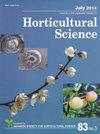Cloning and Expression of cDNAs for Biosynthesis of Very-long-chain Fatty Acids, the Precursors for Cuticular Wax Formation, in Carnation (Dianthus caryophyllus L.) Petals
Journal of The Japanese Society for Horticultural Science
Pub Date : 2013-01-01
DOI:10.2503/JJSHS1.82.161
引用次数: 2
Abstract
The cuticle, composed of cutin and associated waxes, probably acts as a barrier against water evaporation from the epidermal surface of flower petals. Cuticle formation begins with the biosynthesis of very-long-chain fatty acids (VLCFAs), catalyzed by a fatty acid elongase complex in epidermal cells. In the present study, cDNAs were cloned and analyzed for three enzymes (DcKCR1, DcHCD1, and DcECR1). Combined with the previously obtained cDNA for DcKCS1, the present study completes the identification of cDNAs for the fatty acid elongase complex in ‘Light Pink Barbara’ carnation for the first time. DcKCS1 transcripts were accumulated at flower opening stage (Os) 2 through Os 6 (full opening stage) with slight changes, but decreased markedly at senescence stage (Ss) 2 and Ss 4. Also, transcripts for DcKCR1, DcHCD1, and DcECR1 were present in considerable amounts during flower opening stages from Os 2 to Os 6. These findings suggested that the expressions of four genes are active during flower opening stage, which is concomitant with the expansion growth in petals requiring rapid formation of a waxy cuticle. Cut flowers of ‘Miracle Rouge’ carnation have an extremely long vase-life of about three weeks. The cuticle layer on the epidermal cells of ‘Miracle Rouge’ petals was thinner than that of ‘Light Pink Barbara’ petals, and ‘Miracle Rouge’ flowers had a depressed expression of DcKCS1, DcKCR1, and DcHCD1 in petals. These findings suggested that the prolonged vase-life of ‘Miracle Rouge’ flowers is not related to cuticle formation.石竹蜡质形成前体-长链脂肪酸生物合成cdna的克隆与表达花瓣
角质层由角质层和相关蜡质组成,可能起着防止水分从花瓣表皮蒸发的屏障作用。角质层的形成始于长链脂肪酸(VLCFAs)的生物合成,由表皮细胞中的脂肪酸延长酶复合物催化。在本研究中,我们克隆并分析了三种酶(DcKCR1、DcHCD1和DcECR1)的cdna。结合先前获得的DcKCS1 cDNA,本研究首次完成了‘Light Pink Barbara’康乃馨中脂肪酸延长酶复合体的cDNA鉴定。DcKCS1转录本在开放期(Os) 2 ~开放期(Os 6)积累,变化不大,但在衰老期(Ss 2和Ss 4)显著减少。此外,DcKCR1、DcHCD1和DcECR1的转录本在o2 ~ o6开花阶段大量存在。这些结果表明,4个基因的表达在花期是活跃的,这与花瓣的扩张生长相伴随,需要快速形成蜡质角质层。“奇迹胭脂”康乃馨切花的花瓶寿命极长,约为三周。“奇迹胭脂”花瓣表皮细胞角质层比“浅粉芭芭拉”花瓣薄,花瓣中DcKCS1、DcKCR1和DcHCD1的表达均较低。这些发现表明,“奇迹胭脂”花的花瓶寿命延长与角质层的形成无关。
本文章由计算机程序翻译,如有差异,请以英文原文为准。
求助全文
约1分钟内获得全文
求助全文
来源期刊
自引率
0.00%
发文量
0
审稿时长
>36 weeks

 求助内容:
求助内容: 应助结果提醒方式:
应助结果提醒方式:


